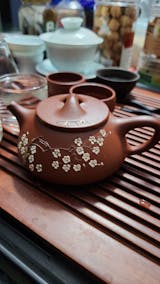
How Yixing Zisha Teapots Are Crafted?
Yixing zisha teapots, renowned for their exquisite artistry and functionality, are handmade using traditional techniques unique to Yixing, China. The process involves meticulous material selection, hand-shaping, and high-temperature firing.
1. Clay Selection & Preparation
l Raw Material: Only locally sourced zisha clay (e.g., purple clay zini, green clay lüni, red clay hongni) is used, prized for its plasticity and mineral richness.
l Weathering & Aging: Crushed ore is exposed to natural weathering, then soaked in water for months to enhance workability.
l Kneading: The clay is hand-wedged to remove air bubbles, creating smooth, homogeneous "ripe clay."
2. Handbuilding Techniques (Core Process)
(1) Forming the Body
l Slab Construction (Round Teapots): Clay slabs are beaten with wooden paddles into cylindrical shapes, then joined with the base and rim.
l Panel Building (Square/Ribbed Teapots): Precisely cut clay panels are assembled into geometric forms, requiring exact measurements.
(2) Attaching Components
l Spout & Handle: The spout is hollowed for optimal water flow; the handle is shaped for balance and comfort.
l Lid & Knob: The lid must fit seamlessly, and the knob is often carved for decoration.
(3) Surface Finishing
l Mingzhen Technique: A buffalo-horn tool burnishes the surface, compacting clay particles for a natural sheen after firing.
l Carving/Inscriptions: Artisans or calligraphers may etch poems or landscapes (taoke engraving) onto the teapot.
3. Drying & Firing
l Slow Drying: Teapots air-dry in shaded areas to prevent cracking (takes days to weeks).
l Kiln Firing:
n Dragon Kiln (Traditional): Wood-fired at 1100°C–1200°C for ~20 hours, producing unpredictable glaze effects.
n Electric Kiln (Modern): Ensures precise temperature control but lacks the rustic charm of wood firing.
l Double Firing: Some teapots are fired twice to refine color or repair minor flaws.
4. Quality Check & Finishing
l Water Flow Test: Ensures smooth pouring and clean water cutoff.
l Polishing: Rarely, teapots are polished or fitted with metal accents.
l Artist’s Seal: The maker’s stamp is pressed onto the base; masterpieces include authenticity certificates.
Key Features
l Full-Handmade vs. Semi-Handmade: Top-tier teapots are entirely shaped by hand (no molds), while semi-handmade versions use molds for efficiency.
l "One Clay, One Teapot": Each piece has unique clay composition and firing results.
l Ergonomics: Spout angle, handle grip, and lid fit are rigorously tested.
Did You Know?
l "Seasoning": Zisha teapots develop a patina (baojiang) over time when rinsed with tea.
l Legendary Artisans: Masters like Shi Dabin (Ming Dynasty), Chen Mingyuan (Qing), and Gu Jingzhou (modern) set enduring standards.
In 2014, Yixing zisha pottery was inscribed as a National Intangible Cultural Heritage of China. Each teapot embodies the artisan’s mastery of clay and centuries of tradition.

